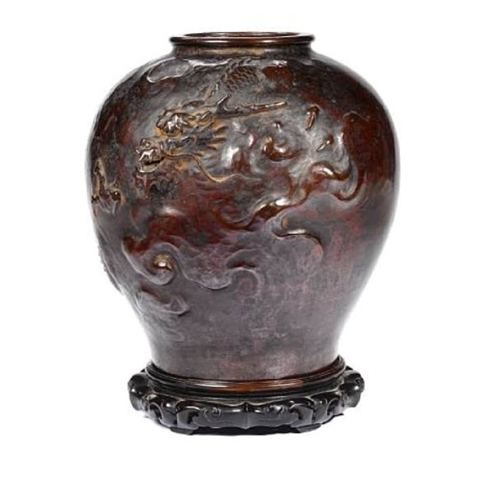Name Oshima Joun | ||
 | ||
Ōshima Joun (大島如雲, Ōshima Joun, 1858 – 1940) was a Japanese sculptor and artist, noted for his great artistry and skill in bronze casting.
Career

Joun was born to a family of metalworkers and was famous for his skill in casting bronze. He was the son of Ōshima Takajiro, whose own father Ōshima Yasubei was the first metal craftsman in the family. He was a professor at the Tokyo School of Fine Arts (東京美術学校 Tōkyō Bijutsu Gakkō; name changed in 2008 to Tokyo University of the Arts) from 1887 until 1932. His studio, Sanseisha — run with his brother Ōshima Yasutaro, also a skilled artist — was very successful and at one point employed 11 assistants. During the period 1875 to 1879, the studio "produced some of the finest bronzes ever produced in Japan." Old labels on Joun's tomobako (wooden storage boxes) suggest that the well-established Ginza, Tokyo purveyor of silver and other fine metal wares Miyamoto-Shoko (established 1880) may also have handled some of Joun's sales.
Many of Joun's students (Ryūki, Chōkichi Suzuki (see mention in Victoria and Albert Museum), Sessei Okazaki, Kumazō Hasegawa, Gorosaburō Kanaya, Eisuke Jomi) went on to achieve distinction of their own. He exhibited at the 2nd National Industrial Exposition in 1881, and at the Paris Exposition Universelle (1900), and the Japan-British Exhibition of 1910.
There appears to be some debate about the correct attribution of the gō (or art-name) Ōshima Joun to either Ōshima Katsujiro or his brother Ōshima Yasutaro. Both were noted artists in metal, and there was another gō in use at the time, Ōshima Shōkaku (var. Shokaken), but there appears to be confusion about which brother should properly be associated with each of these art names. The Oshima Joun obituary at the National Research Institute for Cultural Properties appears to preference Ōshima Katsujiro taking Ōshima Joun, and Captain F. Brinkley's 1902 Japan: Its History, Arts, and Literature, also asserts that Ōshima Katsujiro used the Ōshima Joun gō, but an authoritative history of the matter is needed.
Ōshima Joun died in Tokyo on January 4, 1940, at 83 years old.
